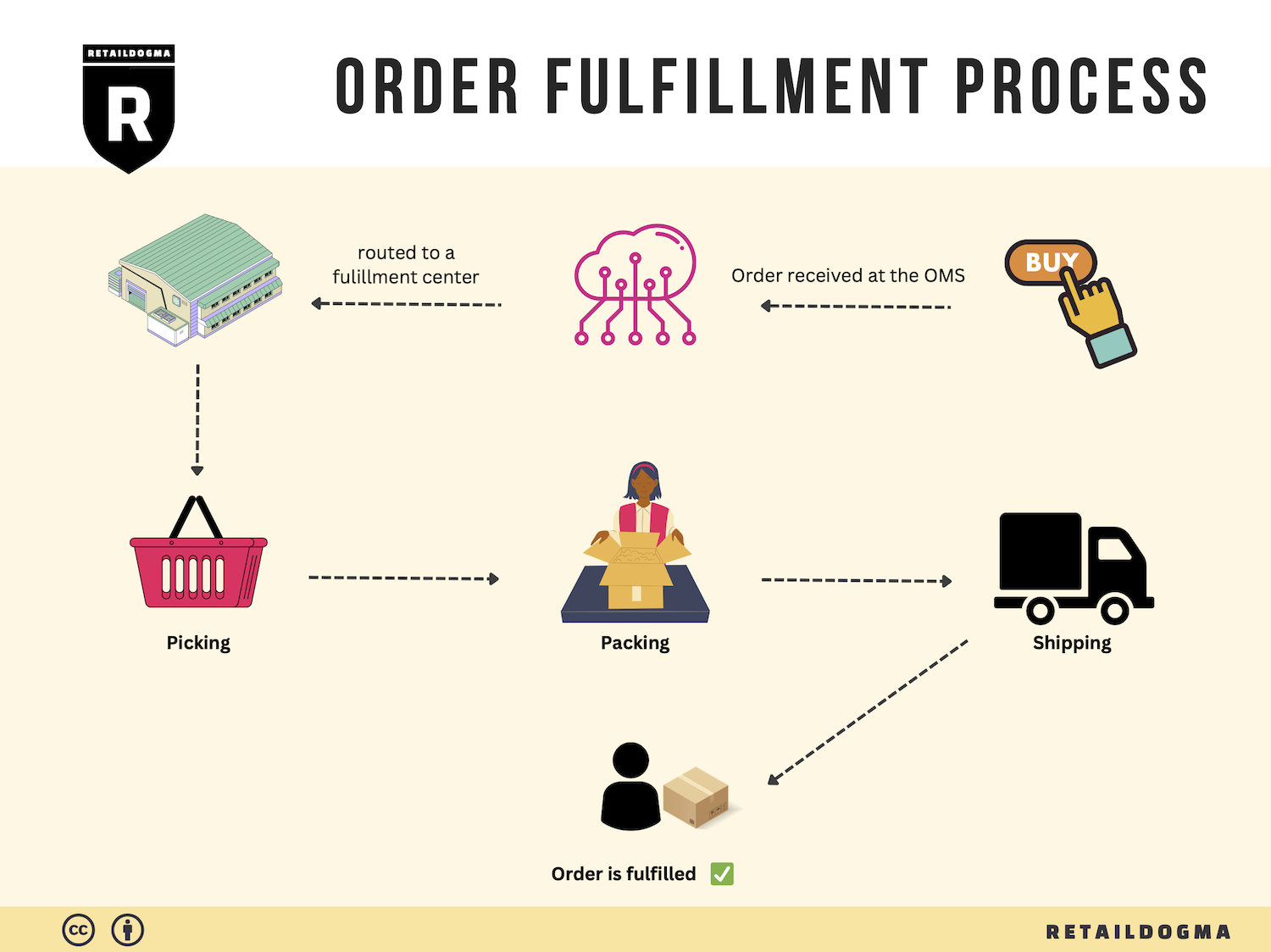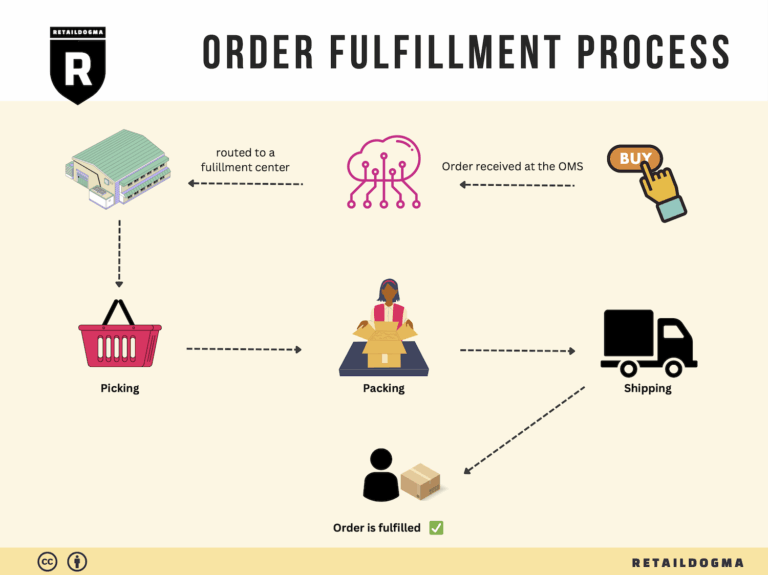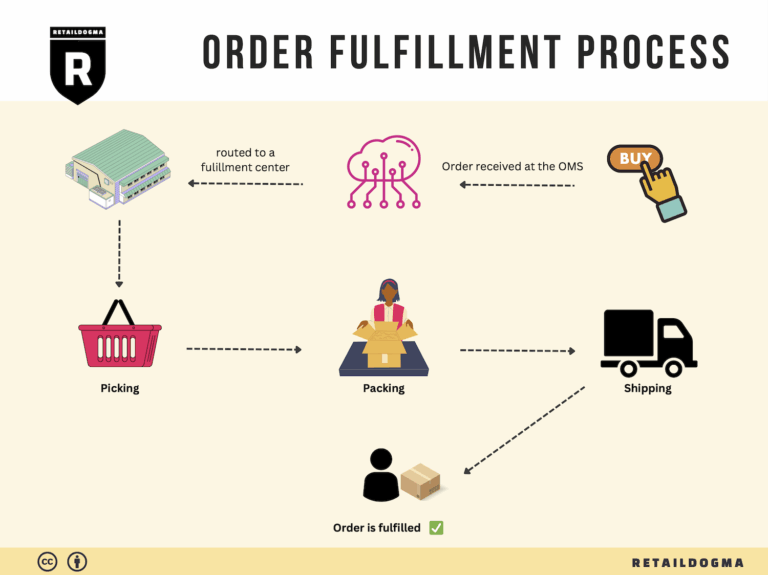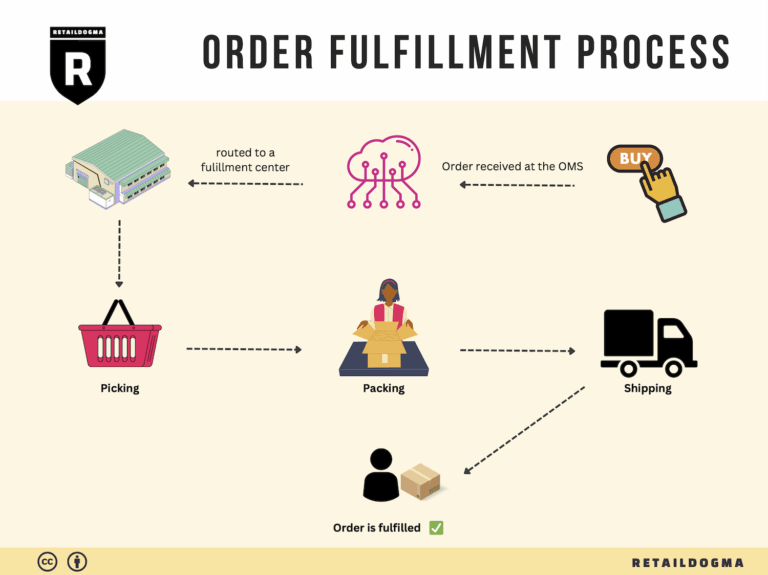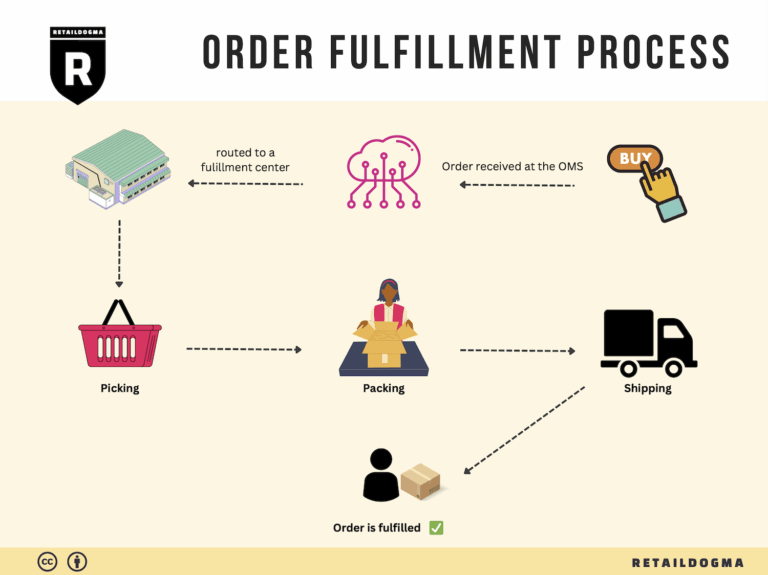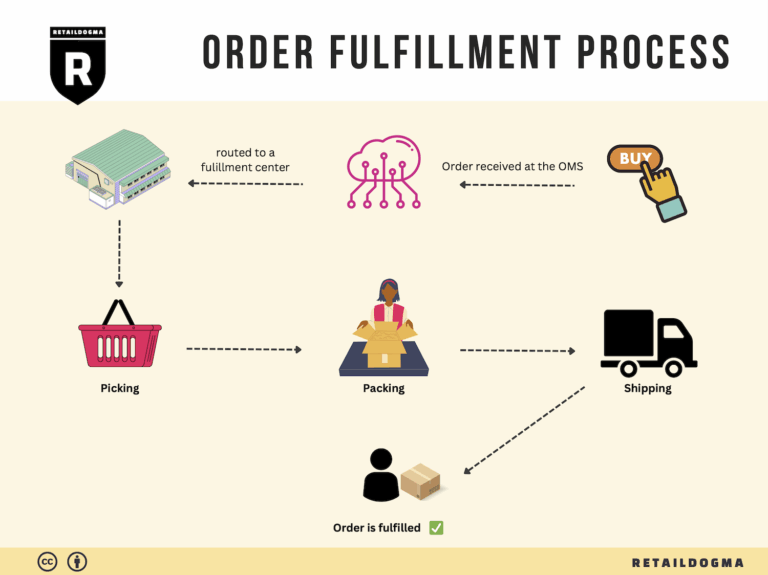Ecommerce Fulfillment Services: The Ultimate Guide (2025)
What is E-commerce Fulfillment? An Introduction for Growing Businesses
Understanding the Fulfillment Process
For many growing e-commerce businesses, the excitement of sales can quickly turn into an overwhelming burden. As orders start to pour in, the intricate tasks of packing and shipping can feel like an insurmountable challenge. Ensuring that each package is prepared accurately and dispatched promptly is crucial for maintaining customer satisfaction and fostering repeat business. This is where the fulfillment process becomes vital. Simply put, fulfillment is the systematic process of getting a product from your warehouse or fulfillment center to your customer’s doorstep.
In this guide, we will delve into the various fulfillment models that are essential for your e-commerce success. You’ll learn about the advantages of partnering with a Third-Party Logistics (3PL) provider versus managing Fulfillment by Amazon (FBA), along with other options that may suit your business’s unique needs. Understanding these different models will help you identify the best approach for your operations as you scale.
We will also explore the core services that are typically offered within the fulfillment process, including inventory management, order processing, kitting, and returns handling. Each of these services plays a crucial role in ensuring that your business operates smoothly and efficiently. By leveraging these services, you can improve your operational efficiency and enhance the overall customer experience.
Choosing the right fulfillment partner is a critical decision that can significantly impact your business’s growth trajectory. This guide will provide practical insights on how to evaluate potential partners based on their capabilities, technology, and customer service.
Additionally, we will discuss pricing structures, helping you understand the cost implications of different fulfillment strategies. Knowing what to expect in terms of pricing will empower you to make informed financial decisions and budget effectively as you grow.

Ultimately, this guide aims to equip you with the knowledge and tools necessary to make smart decisions about your logistics strategy. By understanding the fundamentals of e-commerce fulfillment, you can streamline your operations, enhance customer satisfaction, and focus on what truly matters: growing your business.
What You’ll Learn In This Guide
- What is E-commerce Fulfillment? An Introduction for Growing Businesses
- The Order Fulfillment Process: From ‘Buy’ Button to Customer’s Door
- Comparing Fulfillment Models: In-House vs. 3PL vs. Dropshipping
- A Deep Dive into Amazon FBA: Pros, Cons, and Who It’s For
- Core Services Offered by Fulfillment Centers
- How to Choose a Fulfillment Partner: A 6-Point Checklist
- Understanding Fulfillment Pricing: A Breakdown of Common Fees
- Frequently Asked Questions (FAQs) about Fulfillment
- Conclusion: Is Outsourcing Fulfillment the Right Move for Your Business?
- Important Disclaimer
The Order Fulfillment Process: From ‘Buy’ Button to Customer’s Door
1. Receiving Inventory
The order fulfillment process begins with receiving inventory at the fulfillment center. This step involves checking in products that have been shipped from suppliers or manufacturers. Each item is scanned and logged into the Warehouse Management System (WMS), which tracks inventory levels and locations.
This step is crucial because it ensures that the inventory is accurate and ready for future orders. Discrepancies at this stage can lead to stockouts or overstock situations, both of which negatively impact customer satisfaction and sales. A key term associated with this step is SKU (Stock Keeping Unit), which is a unique identifier for each product variant. Proper SKU management helps maintain accurate inventory records and simplifies order processing.
2. Warehouse Storage
Once the inventory is received and logged, it moves to warehouse storage. This step involves organizing the products in the fulfillment center in a systematic manner. Items are stored based on various factors such as size, weight, and demand frequency.
Effective warehouse storage is essential for optimizing space and improving operational efficiency. A well-organized warehouse reduces the time it takes to locate products during order picking, thus speeding up the fulfillment process. The concept of bin locations is critical here, as it refers to specific areas within the warehouse where items are stored. Clear labeling and logical organization of these bin locations facilitate quick access and reduce picking errors.
3. Order Picking
The next step in the fulfillment process is order picking, where items are retrieved from their storage locations to fulfill customer orders. When an order is placed, the WMS generates a pick list, which outlines the items needed for that order and their respective locations in the warehouse.
Order picking is a pivotal step because it directly impacts order accuracy and speed. Efficient picking methods, such as batch picking or zone picking, can enhance productivity. Moreover, utilizing technology like mobile scanners can further streamline this process by ensuring that the correct items are picked and reducing the likelihood of errors. This step is essential for maintaining high levels of customer satisfaction, as timely and accurate order fulfillment is critical to e-commerce success.

4. Order Packing
After items have been picked, they proceed to order packing. In this stage, products are carefully packaged for shipment. This involves selecting appropriate packaging materials, such as boxes, bubble wrap, and packing peanuts, to protect the items during transit.
Packing is vital for minimizing damage during shipping and ensuring that customers receive their orders in pristine condition. Additionally, thoughtful packaging can enhance the unboxing experience, which is increasingly important in today’s competitive e-commerce landscape. A key term here is packing slip, which is a document included in the package that outlines the items being shipped, serving as a confirmation for both the business and the customer.
5. Shipping & Delivery
The final step in the order fulfillment process is shipping and delivery. Once the order is packed, it is labeled and handed over to a carrier for transportation. The choice of shipping method (e.g., ground, air, expedited) depends on the customer’s preferences and the service levels offered by the fulfillment partner.
This step is crucial as it directly affects delivery speed and customer satisfaction. Fast and reliable shipping can set a business apart from its competitors, leading to repeat purchases and positive reviews. Real-time tracking is an important aspect of this phase, allowing customers to monitor their order’s journey. Utilizing last-mile delivery strategies can also enhance service, as this is the final leg of the shipping journey that brings products from a distribution center to the customer’s door.
In summary, understanding and optimizing each step of the order fulfillment process—from receiving inventory to shipping and delivery—are fundamental for e-commerce success. By focusing on these areas, businesses can enhance operational efficiency, improve customer satisfaction, and ultimately drive growth.
Comparing Fulfillment Models: In-House vs. 3PL vs. Dropshipping
Fulfillment Models Comparison
| Model | Who Handles Inventory | Best For (Business Stage) | Key Advantage | Key Disadvantage |
|---|---|---|---|---|
| In-House Fulfillment | The business itself | Startups to Established Businesses | Full control over inventory and processes | High overhead costs and resource demands |
| Third-Party Logistics (3PL) | 3PL provider | Established Businesses Scaling Up | Cost-effective and scalable solutions | Less control over operations |
| Dropshipping | Supplier or manufacturer | Startups and Small Businesses | Low upfront investment | Lower profit margins and reliance on suppliers |
In-House Fulfillment
In-house fulfillment involves managing all aspects of the supply chain within your own organization. This model is ideal for startups to established businesses that want complete control over their inventory and fulfillment processes. By handling storage, picking, packing, and shipping internally, businesses can tailor their operations to meet specific needs and maintain high standards of quality. One of the key advantages of in-house fulfillment is the ability to respond quickly to customer demands, as businesses can immediately adjust inventory levels and shipping practices. However, this model comes with significant overhead costs, including warehouse space, staffing, technology, and equipment, which can strain resources, especially for smaller businesses. Additionally, as order volumes increase, operational complexities can rise, necessitating investments in more sophisticated systems and processes.
Third-Party Logistics (3PL)
Third-party logistics (3PL) providers, such as Savannah River Fulfillment, offer businesses a comprehensive suite of logistics services, including warehousing, order processing, and shipping. This model is particularly beneficial for established businesses looking to scale operations without the burden of managing logistics in-house. By outsourcing fulfillment to a 3PL, companies can leverage their partner’s expertise, technology, and infrastructure to optimize supply chain efficiency and reduce operational costs. The key advantage of using a 3PL is the scalability it provides; businesses can quickly adjust their fulfillment capabilities based on seasonal demand or growth without the need for significant capital investment. However, a potential downside is that companies may lose some control over their inventory and fulfillment processes, which can affect customer experience if not managed carefully. Furthermore, choosing the right 3PL partner is critical, as the quality of service can vary significantly among providers.
Dropshipping
Dropshipping is a fulfillment model where the retailer does not hold inventory but instead relies on suppliers or manufacturers to fulfill orders directly to customers. This model is particularly attractive for startups and small businesses due to its low upfront investment and minimal risk. Retailers can offer a wide range of products without the financial burden of inventory costs, warehousing, or shipping logistics. The key advantage of dropshipping is that it allows entrepreneurs to test new products and markets quickly without committing significant capital. However, dropshipping also comes with several disadvantages. Profit margins are typically lower than other fulfillment methods, as the retailer must pay the supplier’s price without the benefits of bulk purchasing. Additionally, businesses are often at the mercy of their suppliers regarding inventory levels, shipping times, and product quality, which can lead to customer dissatisfaction if not managed properly. Thus, while dropshipping offers flexibility and low barriers to entry, it requires careful supplier selection and customer service management to succeed.
Conclusion
Choosing the right fulfillment model is crucial for e-commerce businesses aiming to scale their operations effectively. Each model—In-House Fulfillment, Third-Party Logistics, and Dropshipping—has its unique advantages and challenges, making it essential for business owners to assess their specific needs, resources, and long-term goals. By understanding these models and their implications, e-commerce entrepreneurs can make informed decisions that align with their business strategy and customer expectations. Whether opting for the control of in-house fulfillment, the scalability of 3PL, or the low-risk approach of dropshipping, a well-planned fulfillment strategy can significantly enhance operational efficiency and customer satisfaction.
A Deep Dive into Amazon FBA: Pros, Cons, and Who It’s For
Understanding Fulfillment by Amazon (FBA)
Fulfillment by Amazon (FBA) is a service offered by Amazon that allows e-commerce sellers to store their products in Amazon’s fulfillment centers. When a customer places an order, Amazon takes care of the packing, shipping, and customer service on behalf of the seller. This service has become increasingly popular among e-commerce businesses due to its convenience and the extensive reach of the Amazon marketplace.
How FBA Works
-
Sign Up and Set Up: Sellers begin by creating an Amazon Seller account. Once registered, they can set up FBA by choosing which products they want to fulfill through Amazon.
-
Inventory Shipment: Sellers prepare their products according to Amazon’s requirements and ship them to designated Amazon fulfillment centers. Amazon provides specific guidelines on packaging and labeling to ensure compliance.
-
Storage and Management: Once the products arrive at Amazon’s warehouses, they are stored until sold. Amazon’s advanced Warehouse Management System (WMS) tracks inventory levels in real-time, helping sellers manage stock efficiently.
-
Order Processing: When a customer orders a product, Amazon picks, packs, and ships the item directly to the customer.
-
Customer Service: Amazon also handles all customer inquiries and returns for FBA orders, providing a seamless experience for both sellers and buyers.
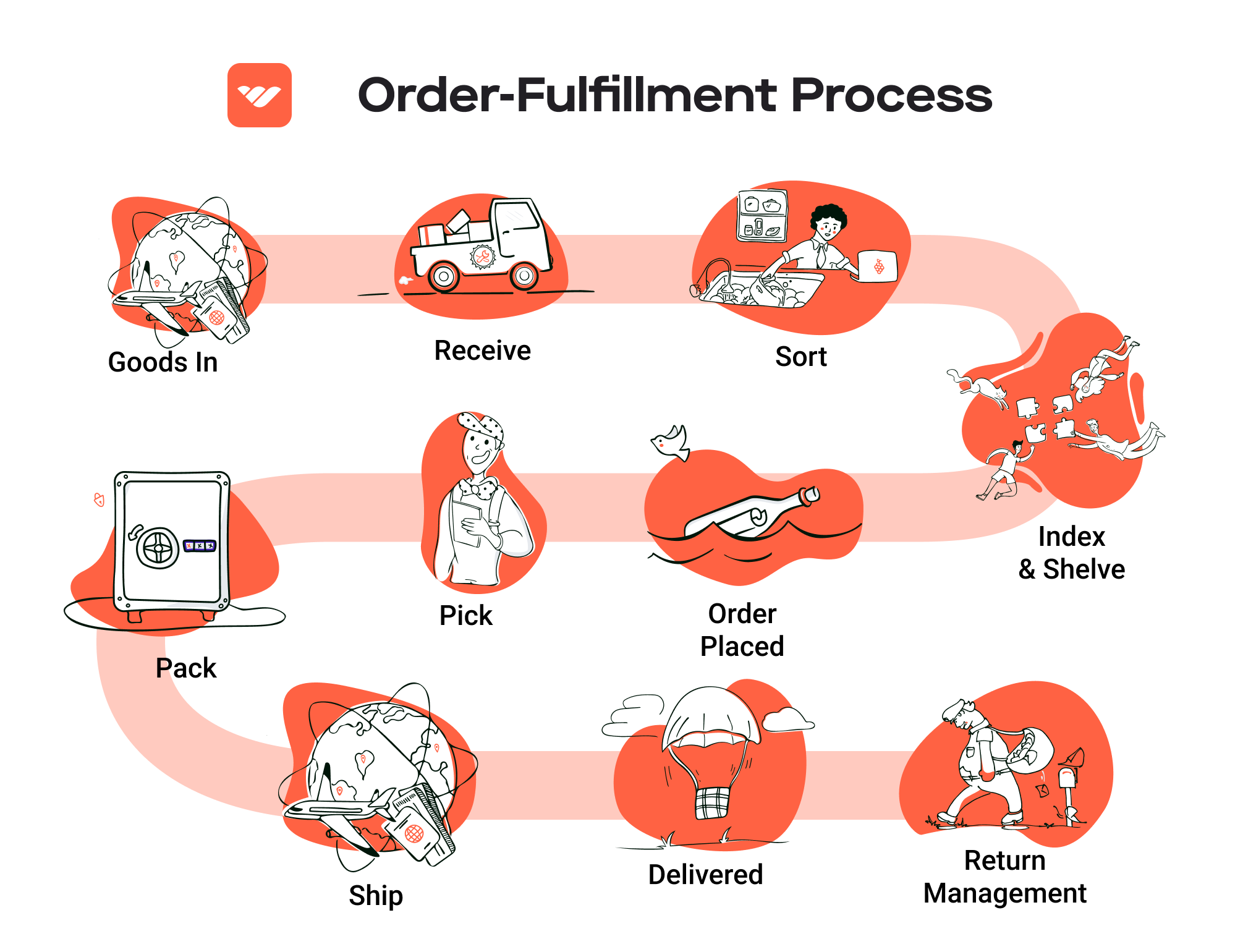
-
Payment and Fees: Sellers receive payment for their sales, minus Amazon’s fees, which include storage and fulfillment costs.
Pros of Using FBA
1. Prime Eligibility
One of the most significant advantages of FBA is the ability for sellers to offer their products to Amazon Prime members. This not only increases the visibility of the products but also attracts a loyal customer base that values fast and free shipping.
2. Customer Trust
Products fulfilled by Amazon are often seen as more trustworthy by customers. The Amazon brand carries a reputation for reliability and excellent customer service, which can enhance the seller’s credibility and increase sales.
3. Multi-Channel Fulfillment
FBA is not limited to Amazon sales. Sellers can use FBA to fulfill orders from other sales channels such as their own websites, eBay, or Shopify. This means that businesses can streamline their logistics and inventory management across multiple platforms.
4. Simplified Logistics
Outsourcing fulfillment to Amazon allows sellers to focus on other aspects of their business, such as marketing and product development. Amazon’s infrastructure handles the complexities of storage, shipping, and customer service.
5. Scalability
FBA enables businesses to scale without the need to invest in their own warehousing or logistics infrastructure. As order volumes increase, sellers can rely on Amazon’s robust fulfillment network to meet demand.
Cons of Using FBA
1. High Fees
While FBA provides many conveniences, it comes at a cost. Amazon charges various fees, including storage fees for inventory held in their warehouses and fulfillment fees based on the size and weight of the products. These costs can significantly eat into profit margins, especially for lower-priced items.
2. Strict Inventory Rules
Sellers must adhere to Amazon’s strict inventory management policies, including limits on how much inventory can be stored based on sales performance. Failure to comply can lead to penalties or restrictions on selling.
3. Commingling Risks
Amazon commingles inventory from different sellers, which means that a seller’s products may be shipped to customers alongside those from other sellers. This can pose risks, such as counterfeit issues or quality control problems, which can affect the seller’s reputation.
4. Less Control Over Customer Experience
While Amazon handles customer service, sellers have limited control over how their products are presented or how customer inquiries are managed. This can be a disadvantage for brands that prioritize personalized customer interactions.
5. Potential for Stockouts
If a seller’s inventory runs low at Amazon’s fulfillment centers, they risk stockouts and lost sales. Managing inventory levels to avoid this requires careful planning and forecasting.
Who is FBA Best For?
Fulfillment by Amazon is particularly advantageous for:
-
New Entrepreneurs: Those just starting in e-commerce can benefit from Amazon’s established infrastructure and customer base without the need to invest heavily in logistics.
-
Established Brands: Brands looking to expand their reach and leverage Amazon’s customer trust can utilize FBA to enhance their sales channels.
-
High-Volume Sellers: Businesses with significant sales volumes can absorb FBA fees more comfortably and benefit from the efficiencies of Amazon’s fulfillment network.
-
Sellers of Consumer Products: Those selling fast-moving consumer goods that require quick turnover can greatly benefit from the speed and efficiency of FBA.
-
Multi-Channel Sellers: Businesses that sell across multiple platforms and want to streamline their fulfillment processes can use FBA for a seamless operation.
In conclusion, while FBA offers numerous advantages for e-commerce businesses, it is essential to carefully consider the associated costs and operational implications. By evaluating your business model and goals, you can determine if FBA aligns with your strategic objectives for growth and customer satisfaction.
Core Services Offered by Fulfillment Centers
Inventory Management & Warehousing
Effective inventory management is the cornerstone of a successful e-commerce operation. Fulfillment centers, such as Savannah River Fulfillment, offer advanced warehousing solutions that include real-time inventory tracking and secure storage facilities. These centers utilize sophisticated Warehouse Management Systems (WMS) that provide e-commerce businesses with visibility into their stock levels, helping them to avoid stockouts or overstock situations.
The benefits of efficient inventory management are manifold. Firstly, it allows businesses to maintain optimal inventory levels, which can significantly reduce carrying costs. By having a clear view of stock availability, businesses can make informed purchasing decisions, ensuring they have enough product on hand to meet customer demand without tying up unnecessary capital in excess inventory.
Moreover, a fulfillment center’s warehousing capabilities enable businesses to scale their operations seamlessly. During peak seasons, such as holidays or promotional events, additional storage space is often necessary. A fulfillment partner can accommodate these fluctuations, allowing businesses to focus on sales and marketing rather than logistics.
Pick and Pack Services
Once an order is received, the next critical step is the pick and pack process. This service involves selecting items from inventory (picking) and preparing them for shipment (packing). Fulfillment centers streamline this process through automation and efficient workflows, ensuring that orders are processed quickly and accurately.
The advantages of utilizing pick and pack services are significant. First and foremost, speed is enhanced, which is crucial in today’s e-commerce landscape where consumers expect rapid delivery. A fulfillment center can typically process orders much faster than an in-house team, thanks to optimized workflows and dedicated staff.
Additionally, accuracy is improved. Advanced technology, including mobile scanning devices and real-time inventory updates, ensures that the correct items are picked for each order, minimizing the risk of errors that can lead to customer dissatisfaction. This level of service not only enhances the customer experience but also fosters brand loyalty and repeat business.
Kitting and Assembly
Kitting and assembly is another vital service offered by fulfillment centers that can significantly benefit e-commerce businesses. This process involves bundling individual items together to create a single, cohesive product, such as promotional kits, subscription boxes, or product bundles.
Utilizing kitting services can lead to substantial time savings for e-commerce businesses. By outsourcing this task to a fulfillment center, businesses can focus on their core competencies, such as product development and marketing, rather than the labor-intensive process of assembling kits. Additionally, kitting can enhance the customer experience by providing unique product offerings that are attractive and ready for immediate use.
Moreover, kitting can improve inventory management. By consolidating multiple items into a single SKU, businesses can simplify their inventory tracking and reduce the complexity associated with managing numerous individual products. This can lead to lower holding costs and easier forecasting.
Returns Management (Reverse Logistics)
In the realm of e-commerce, returns are an inevitable reality. A well-structured returns management process, often referred to as reverse logistics, is essential for maintaining customer satisfaction and protecting a brand’s reputation. Fulfillment centers provide comprehensive returns management services that simplify the return process for customers and businesses alike.
The primary benefit of effective returns management is the ability to turn a potentially negative experience into an opportunity for customer retention. A streamlined returns process ensures that customers can easily return items, receive timely refunds or exchanges, and have their concerns addressed quickly. This level of service can transform dissatisfied customers into loyal advocates for your brand.
Additionally, fulfillment centers typically handle the inspection, restocking, and refurbishment of returned items. This not only ensures that products can be resold quickly but also minimizes losses associated with returns. By efficiently managing returns, e-commerce businesses can recover value from returned products and maintain healthier profit margins.
Conclusion
In today’s competitive e-commerce landscape, partnering with a fulfillment center that offers a comprehensive suite of services is essential for growth and efficiency. From inventory management and warehousing to pick and pack, kitting, and returns management, these core services provide the necessary support for businesses to scale their operations effectively. By leveraging the expertise and technology of fulfillment centers like Savannah River Fulfillment, e-commerce businesses can focus on what they do best—delivering exceptional products and experiences to their customers.
How to Choose a Fulfillment Partner: A 6-Point Checklist
Location & Warehouse Network
Choosing a fulfillment partner with strategically located warehouses is crucial for minimizing shipping times and costs. Proximity to major shipping routes and ports can significantly enhance delivery speed, particularly if your business serves customers across the country or internationally.
Questions to Ask:
– Where are your warehouses located, and how does that align with my target customer base?
– What is your average shipping time to major cities from your warehouses?
– Do you have the capability to scale with additional locations if my business grows?
Technology & Integrations
In today’s digital landscape, the ability to integrate seamlessly with your e-commerce platform is vital. A robust Warehouse Management System (WMS) will provide real-time inventory tracking, order processing updates, and data analytics to help you make informed decisions.
Questions to Ask:
– What technology do you use for inventory management and order fulfillment?
– Can your system integrate with my current e-commerce platforms (e.g., Shopify, Amazon, WooCommerce)?
– How do you handle system updates or potential downtime?
Specializations (e.g., Cold Storage, Oversized Items)
Different businesses have unique needs, whether it’s handling perishables that require cold storage or oversized items that need specialized handling. Selecting a 3PL partner with the right specialization can prevent potential logistical headaches and ensure compliance with industry regulations.
Questions to Ask:
– What specific services do you offer that cater to my product type?
– Are you equipped to handle specialized storage needs (e.g., temperature control, hazardous materials)?
– Can you manage unique packaging requirements for my products?
Scalability & Capacity
As your business grows, your fulfillment needs may change. A suitable 3PL partner should have the capacity to scale operations in response to your business’s growth, seasonal fluctuations, or increased product lines without compromising service quality.
Questions to Ask:
– How do you handle seasonal surges in order volume?
– What is your current capacity, and how can you accommodate growth?
– Are there any limitations on the types of products or volumes you can manage?
Pricing and Contracts
Understanding the pricing structure and contract terms upfront is essential to avoid unexpected costs down the line. Look for transparency in pricing and ensure you understand what services are included in the contract.
Questions to Ask:
– What is your pricing model (e.g., per order, monthly fees, storage costs)?
– Are there any hidden fees associated with your services?
– Can you provide a sample contract for review, and what are the terms for cancellation or changes?
Customer Support & Reviews
Finally, exceptional customer support can make a significant difference in your operational efficiency. A responsive support team can help resolve issues quickly, minimizing disruptions to your business. Additionally, checking reviews and testimonials can provide insights into the experiences of other businesses.
Questions to Ask:
– What customer support channels do you offer (e.g., phone, email, chat)?
– What are your response times for support inquiries?
– Can you provide references or case studies from similar businesses that have used your services?
Conclusion
Choosing the right fulfillment partner is a critical decision that can significantly impact your e-commerce operations. By carefully evaluating potential partners against this checklist, you can ensure that you select a provider that aligns with your business goals and supports your growth. As you consider Savannah River Fulfillment or any other 3PL partner, focus on these essential criteria to make an informed decision that will set your business up for success in the competitive e-commerce landscape.
Understanding Fulfillment Pricing: A Breakdown of Common Fees
Initial Setup Fees
When engaging a third-party logistics (3PL) provider like Savannah River Fulfillment, businesses may encounter initial setup fees. These fees cover the costs associated with integrating your e-commerce platform with the 3PL’s Warehouse Management System (WMS). This process often includes system configuration, training on how to use the software, and initial inventory setup.
The calculation of these fees can vary widely based on the complexity of the integration and the specific requirements of your business. Typically, you can expect a one-time charge that may range from a few hundred to several thousand dollars. It’s important to clarify what is included in this fee—such as technical support or additional training—before moving forward.
Receiving Fees
Receiving fees are charges incurred when your inventory arrives at the fulfillment center. These fees cover the labor and resources required to unload, inspect, and store your products. The costs are generally calculated per unit or per shipment, depending on the volume of goods being received.
For example, if you send a shipment of 1,000 units, you might be charged a flat rate for the entire shipment or a per-unit fee. Be sure to ask how the 3PL calculates receiving fees—some may have minimum charges or additional costs for special handling (e.g., fragile items or bulk shipments).
Storage Fees (per pallet/bin)
Storage fees are recurring costs that businesses pay for the space their inventory occupies within the fulfillment center. These fees are typically calculated on a per pallet or per bin basis, depending on how your inventory is organized in the warehouse.
For example, if your products are stored on pallets, you would pay a set fee for each pallet stored, which could range from $10 to $30 per month. Alternatively, if your items are stored in bins, you might pay a monthly fee based on the size and volume of the bins used. Understanding the storage model of your 3PL provider is crucial, especially during peak seasons when inventory levels may fluctuate significantly.
Pick & Pack Fees (per item/order)
Pick and pack fees are charged for the labor involved in selecting items from the warehouse and packing them for shipment. This process includes picking the correct products, packing them securely, and preparing them for dispatch.
These fees are usually calculated on a per-item or per-order basis. For example, a 3PL might charge $0.50 per item for picking and packing, or a flat fee of $2.00 per order, regardless of the number of items. It’s essential to clarify whether the fees cover additional services, such as custom packing or special packaging materials.
Shipping Fees
Shipping fees are one of the most variable costs associated with fulfillment services, as they depend on several factors including package weight, dimensions, destination, and the shipping carrier used. Many 3PL providers negotiate rates with carriers, which can affect the shipping costs passed on to you.
Shipping fees may be calculated based on the dimensional weight (a pricing technique used by carriers that factors in the size of the package) or the actual weight of the shipment. Businesses should inquire about the shipping options available, including express services, and whether the 3PL offers real-time rate shopping to find the most cost-effective solutions.
Tips for Getting an Accurate Quote
-
Be Transparent About Your Needs: Provide the 3PL with detailed information about your inventory, expected order volumes, and any special requirements (like seasonal spikes). This allows them to tailor their quote to your specific situation.
-
Request a Comprehensive Breakdown: Ask for a detailed breakdown of all fees involved, including setup, receiving, storage, pick & pack, and shipping fees. This helps to avoid hidden costs later on.
-
Compare Multiple Providers: Don’t settle for the first quote you receive. Compare offers from various 3PL providers to ensure you’re getting the best value.
-
Consider Long-Term Costs: Look beyond initial fees and evaluate the total cost of fulfillment over time, including potential increases in storage fees or shipping costs.
-
Negotiate Terms: Many 3PL providers are open to negotiation, especially if you plan to bring significant volume. Discuss possible discounts for long-term contracts or bulk shipping.
By understanding these common fulfillment pricing models and following these tips, e-commerce businesses can make informed decisions and select the right fulfillment partner to support their growth.
Frequently Asked Questions (FAQs) about Fulfillment
1. What is Savannah River Fulfillment?
Savannah River Fulfillment is a leading third-party logistics (3PL) provider located in Georgia, USA. We specialize in comprehensive fulfillment services, including order processing, warehousing, kitting, and returns management. Our advanced technology and strategically located facilities enable us to provide efficient and scalable logistics solutions tailored to the needs of e-commerce businesses.
2. What is a 3PL?
A third-party logistics (3PL) provider is a company that offers outsourced logistics services to businesses. This includes transportation, warehousing, inventory management, order fulfillment, and distribution. Utilizing a 3PL can help businesses focus on their core competencies while leaving the complexities of logistics to experts.
3. How does Savannah River Fulfillment integrate with my e-commerce platform?
Savannah River Fulfillment offers seamless integration with various e-commerce platforms such as Shopify, WooCommerce, Amazon, and more. By connecting your online store to our advanced Warehouse Management System (WMS), you can automate order processing, manage inventory in real-time, and enhance the overall customer experience.
4. How much do fulfillment services cost?
The cost of fulfillment services can vary based on several factors, including the volume of orders, the size and weight of products, and the specific services required (such as kitting or returns processing). Savannah River Fulfillment provides customized pricing based on your unique needs, ensuring you only pay for the services that benefit your business.
5. What’s the difference between a warehouse and a fulfillment center?
A warehouse primarily focuses on storing goods, while a fulfillment center is designed for order processing, packing, and shipping products directly to customers. Fulfillment centers are equipped with advanced technology to manage inventory and streamline the delivery process, ensuring timely fulfillment of customer orders.
6. What fulfillment services does Savannah River Fulfillment offer?
Savannah River Fulfillment offers a comprehensive suite of services, including:
– Order Fulfillment
– Omnichannel Fulfillment
– Amazon FBA Prep
– Kitting Services
– Return Processing
– Warehousing Solutions
– TikTok Shop Fulfillment
These services are tailored to meet the diverse needs of e-commerce businesses.
7. How does Savannah River Fulfillment handle returns?
Our return processing system is designed to efficiently assess, restock, or refurbish returned items. By streamlining this process, we aim to turn returns into opportunities for customer retention and satisfaction. Our team ensures that returns are handled promptly, maintaining communication with your business throughout the process.
8. Can Savannah River Fulfillment support seasonal fluctuations in demand?
Yes, Savannah River Fulfillment offers flexible warehousing solutions that can adapt to your business’s seasonal needs. Whether you experience peak sales during holidays or promotional events, our scalable operations can accommodate increased inventory and order volume, ensuring you can meet customer demand without disruptions.
9. How quickly can orders be fulfilled and shipped?
With our state-of-the-art facilities located near major transportation hubs, Savannah River Fulfillment can ensure rapid order fulfillment. Typically, orders can be shipped to destinations within the Southeastern United States in two days and reach other areas in the U.S. within 3-5 days using ground shipping methods.
10. What technology does Savannah River Fulfillment use for inventory management?
We utilize an advanced Warehouse Management System (WMS) that provides real-time inventory tracking and order processing capabilities. This technology allows for 100% inventory accuracy, mobile scanning solutions, and detailed reporting, enabling you to monitor your inventory and order status at any time.
Conclusion: Is Outsourcing Fulfillment the Right Move for Your Business?
Evaluating the Benefits of Outsourcing Fulfillment
Outsourcing fulfillment can be a transformative decision for e-commerce businesses seeking to scale efficiently. One of the most significant advantages is time savings. By partnering with a third-party logistics provider like Savannah River Fulfillment, business owners can offload the complexities of order processing, inventory management, and shipping logistics. This allows you to concentrate on core business functions such as marketing, product development, and customer engagement, ultimately driving growth.
Scalability is another critical benefit. As your business expands, your fulfillment needs will evolve. A proficient fulfillment partner can seamlessly adjust to your changing requirements, whether you’re experiencing seasonal spikes in demand or launching new product lines. With facilities strategically located to optimize shipping times, you can ensure that your customers receive their orders promptly, enhancing their overall shopping experience.
Moreover, leveraging the expertise of a specialized fulfillment provider allows you to benefit from industry best practices and advanced technology, such as real-time inventory tracking and automated order processing. This not only boosts operational efficiency but also minimizes the risk of errors that can arise from manual handling.
However, the success of outsourcing fulfillment hinges on choosing the right partner. It’s essential to conduct thorough research and evaluate potential logistics providers based on their capabilities, service levels, and alignment with your business goals.
To determine if outsourcing is the right move for your business, consider auditing your current shipping processes. Assess your operational bottlenecks, customer satisfaction rates, and overall fulfillment costs. This analysis will provide valuable insights into whether partnering with a fulfillment service like Savannah River Fulfillment could propel your business to new heights. Don’t let logistics challenges hinder your growth; take the first step towards a more efficient supply chain today.
Important Disclaimer
⚠️ Important Disclaimer
The information in this guide is for educational purposes. Fulfillment services, pricing, and platform features change frequently. Always conduct your own due diligence and consult with providers directly before making business decisions.
